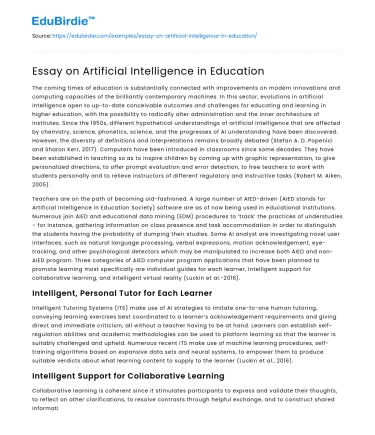The coming times of education is substantially connected with improvements on modern innovations and computing capacities of the brilliantly contemporary machines. In this sector, evolutions in artificial intelligence open to up-to-date conceivable outcomes and challenges for educating and learning in higher education, with the possibility to radically alter administration and the inner architecture of institutes. Since the 1950s, different hypothetical understandings of artificial intelligence that are affected by chemistry, science, phonetics, science, and the progresses of AI understanding have been discovered. However, the diversity of definitions and interpretations remains broadly debated (Stefan A. D. Popenici and Sharon Kerr, 2017). Computers have been introduced in classrooms since some decades. They have been established in teaching so as to inspire children by coming up with graphic representation, to give personalized directions, to offer prompt evaluation and error detection, to free teachers to work with students personally and to relieve instructors of different regulatory and instructive tasks (Robert M. Aiken, 2005).
Teachers are on the path of becoming old-fashioned. A large number of AIED-driven (AIED stands for Artificial Intelligence in Education Society) software are as of now being used in educational institutions. Numerous join AIED and educational data mining (EDM) procedures to ‘track’ the practices of understudies – for instance, gathering information on class presence and task accommodation in order to distinguish the students having the probability of dumping their studies. Some AI analyst are investigating novel user interfaces, such as natural language processing, verbal expressions, motion acknowledgement, eye-tracking, and other psychological detectors which may be manipulated to increase both AIED and non-AIED program. Three categories of AIED computer program applications that have been planned to promote learning most specifically are individual guides for each learner, Intelligent support for collaborative learning, and Intelligent virtual reality (Luckin et al.-2016).
Save your time!
We can take care of your essay
- Proper editing and formatting
- Free revision, title page, and bibliography
- Flexible prices and money-back guarantee
Intelligent, Personal Tutor for Each Learner
Intelligent Tutoring Systems (ITS) make use of AI strategies to imitate one-to-one human tutoring, conveying learning exercises best coordinated to a learner’s acknowledgement requirements and giving direct and immediate criticism, all without a teacher having to be at hand. Learners can establish self-regulation abilities and academic methodologies can be used to platform learning so that the learner is suitably challenged and upheld. Numerous recent ITS make use of machine learning procedures, self-training algorithms based on expansive data sets and neural systems, to empower them to produce suitable verdicts about what learning content to supply to the learner (Luckin et al., 2016).
Intelligent Support for Collaborative Learning
Collaborative learning is coherent since it stimulates participants to express and validate their thoughts, to reflect on other clarifications, to resolve contrasts through helpful exchange, and to construct shared information and meaning. AIED can contribute in making collaboration prompt by concentrating mainly on four approaches namely adaptive group formation, expert facilitation, virtual agents, and intelligent moderation. The aim of adaptive group formation is to plan a gathering of students all at a corresponding awareness level and of similar preferences, or one where the participants bring diverse but interrelated knowledge and aptitudes. In expert facilitation, models of compelling collaboration, known as ‘collaboration patterns’, are used to supply interactive assistance to the collaborative learners. Intelligent virtual agents might resolve online student interaction, or basically promote dialogues (Luckin et al., 2016).
Intelligent Virtual Reality to Support Learning
Virtual Reality bears real immersive encounter (the subjective impression that one is taking part in a practical encounter) that replicate a few angles of the real world to which the user would not otherwise have access (such as unpredictable situations or somewhere geographically or typically unreachable). Studies has revealed that offering possibilities for students to discover, engage with, and control elements of a simulated world, helps them to translate to the real word what they have experienced. When combined with Artificial Intelligence, virtual reality is ‘intelligent’ (Luckin et al., 2016).
Teachers and AIED
Teachers have to undoubtedly be the key agents within the following stage of AIED. It is them who will be the orchestrators of when and how to use the AIED devices. Free from schedule, time-consuming engagements will enable instructors to commit more of their energies to the innovative and uncommonly human acts that allow the creativity and sympathy required to move learning to the upcoming level. With this modification, instructors will have to generate advanced skills (Luckin et al., 2016).
Conclusion
AI is likely to have a significant effect on education and it has the ability to change education due to both its advantages and drawbacks. It is imperative that teachers, learning researchers and policymakers engage with computer scientists and AI developers to ensure that artificial intelligence in education meets real needs. We ought to be striking and not constrain our imagination to existing technologies. But we must not be enticed by the bait of thrilling innovations (Holmes et al., 2019). Bearing in mind that AI can ease the world enormously, it should be well evaluated before being employed for human convenience or in the greed to play God, man may destroy himself (Naeem Moosbally, 2018).






 Stuck on your essay?
Stuck on your essay?

